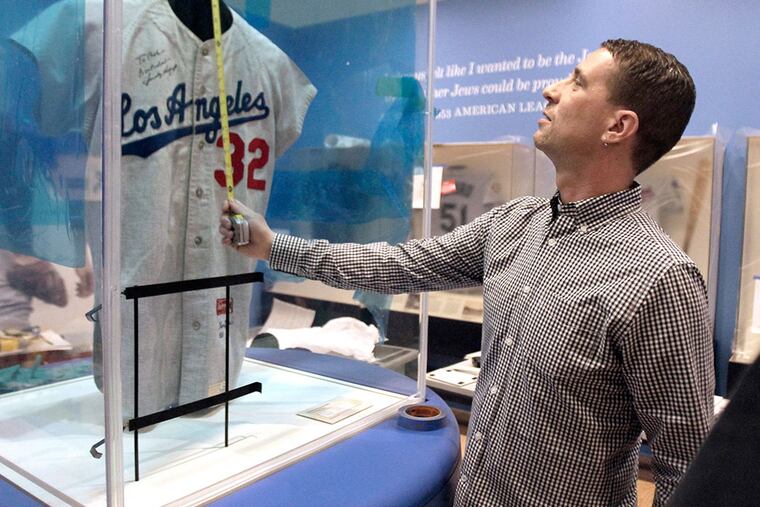'Chasing Dreams' down the first-base line
Sandy Koufax, the great Dodgers pitcher, took his religion seriously. Maybe he didn't attend services regularly, but he was infused with Jewish culture and tradition.

Sandy Koufax, the great Dodgers pitcher, took his religion seriously. Maybe he didn't attend services regularly, but he was infused with Jewish culture and tradition.
When the first game of the 1965 World Series against the Minnesota Twins fell on Yom Kippur, Koufax was stricken - he never pitched on the holiest of days. He made the difficult decision to continue this observance, World Series or not.
Besides, his fellow ace, Don Drysdale, was ready and able to carry the Dodgers.
Drysdale took the mound that Oct. 6 in Bloomington, Minn., and things were OK for the first two innings. But in the third, the Twins began pummeling him. Hits. Walks. Disaster.
Dodgers manager Walter Alston made the ritualistic trudge to the mound to yank his man.
When Drysdale handed Alston the ball, he said, "I know, Skip, you're wishing I were a Jew."
This anecdote occupies only a moment in the rich, sprawling new exhibition "Chasing Dreams: Baseball and Becoming American" that opens Thursday at the National Museum of American Jewish History.
But that moment weaves together many of the threads of the show, co-curated by Josh Perelman, the museum's chief curator and director of exhibitions and collections, and Ivy Weingram, museum associate curator. It runs through Oct. 26 and will then travel to venues now being finalized.
Koufax is one of the stars of "Chasing Dreams" - along with Detroit Tigers slugger Hank Greenberg, Dodgers icon Jackie Robinson, and 19th-century superstar Lipman Pike.
"People usually think about baseball as a sporting event, what they do in their leisure time," said Perelman, walking through the exhibition as it was being installed.
Vacuums whirred. Saws screeched. Cases containing such artifacts as the last home plate at the Polo Grounds, the original sheet music of "Take Me Out to the Ball Game," an 1866 baseball commemorating the Philadelphia Athletics' loss to the Unions of Morrisania (in what is now the South Bronx) were unfinished. Photographs galore - Koufax, Greenberg, Joe DiMaggio, Roberto Clemente, Juan Marichal, Ichiro Suzuki - were waiting to be hung.
"Baseball has a rich history of engagement with minority groups," Perelman said. "It represents the diversity of our nation, a microcosm of our pluralistic society."
This theme ties the show together. Koufax was a Jew, but on the field he was a ballplayer, just like Drysdale. For Jews, for Italians, for Irish, for blacks and Latinos, participation in the "national pastime" became a ticket into mainstream society.
Greenberg, the Hebrew Hammer, played for Detroit in the 1930s and '40s. When he was dealt to Pittsburgh in 1947, Detroit fans were outraged. Yet those same fans had relentlessly showered him with anti-Semitic epithets when he was on the field.
Jackie Robinson, of course, dealt with far worse.
Baseball, in other words, has provided a relatively even field for Jews, Italian Americans, and other white ethnic groups, but it has not and cannot wipe out the cultural divisions in the wider society.
Nowhere can that be seen with greater clarity than with African American players.
"Jackie Robinson broke the color line in baseball" in 1947, Perelman noted. "But it took America another two or three decades to ban segregation."
Robinson - widely viewed as the game's greatest hero - served as inspiration to every member of every excluded group in the nation. But he could hardly erase racial hostility between the chalk lines by himself, let alone in the wider society outside the ballpark.
In 1960, when the team from Levittown, Pa., won the Little League World Series, defeating Fort Worth, Texas, no African American kid represented Levittown and signed the commemorative bat, Perelman said. The bat is in the exhibition, along with about 130 other objects.
"There are no African American names on the bat," said Perelman, "and Levittown itself struggled with integration. . . . Jackie Robinson's achievements took time to impact all of our communities."
But Robinson and Koufax were teammates in the mid-1950s, the former at the end of his career, the latter just beginning. By the time Don Drysdale departed from his disastrous World Series game in 1965, African Americans were on every team, along with Jews, Italian Americans, Irish Americans, Afro-Caribbeans, and Latin players. Asians came a bit later. In fact, Greenberg, a generation before Koufax, sat out Yom Kippur with considerable support from Detroit Tigers fans, although the game did not have the significance of the World Series.
"Chasing Dreams" reflects all this, while also exploring the roles of women, Jewish team owners and concessionaires, and even the shifting attitudes of white and black team owners toward each other.
The exhibition comes with a lively companion book, edited by Perelman, that contains essays and even fiction from some of the country's finest writers. Baseball seems to bring out the best in a writer, perhaps because the game lends itself so seamlessly to myth and metaphor - and sentimentality and nostalgia.
Philip Roth, in My Baseball Years, ruminates on its allure:
"For someone whose roots in America were strong but only inches deep, and who had no experience, such as a Catholic child might, of an awesome hierarchy that was real and felt, baseball was a kind of secular church that reached into every class and region of the nation and bound millions upon millions of us together in common concerns, loyalties, rituals, enthusiasms and antagonisms. Baseball made me understand what patriotism was about, at its best."
215-854-5594
@SPSalisbury